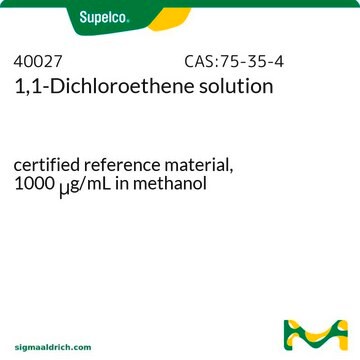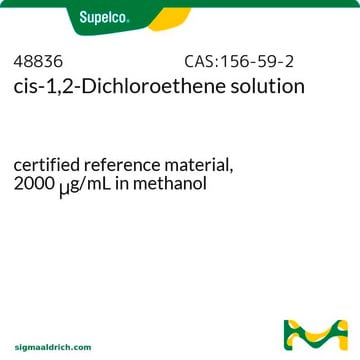Wichtige Dokumente
163023
1,1-Dichlorethylen
contains 200 ppm MEHQ as inhibitor, 99%
Synonym(e):
Vinylidenchlorid
About This Item
Empfohlene Produkte
Dampfdichte
3.46 (vs air)
Dampfdruck
9.68 psi ( 20 °C)
Assay
99%
Form
liquid
Selbstzündungstemp.
968 °F
Enthält
200 ppm MEHQ as inhibitor
Expl.-Gr.
15.5 %
bp
30-32 °C (lit.)
mp (Schmelzpunkt)
−122 °C (lit.)
Dichte
1.213 g/mL at 20 °C (lit.)
Lagertemp.
2-8°C
SMILES String
ClC(Cl)=C
InChI
1S/C2H2Cl2/c1-2(3)4/h1H2
InChIKey
LGXVIGDEPROXKC-UHFFFAOYSA-N
Suchen Sie nach ähnlichen Produkten? Aufrufen Leitfaden zum Produktvergleich
Anwendung
Signalwort
Danger
Gefahreneinstufungen
Acute Tox. 3 Oral - Acute Tox. 4 Inhalation - Carc. 2 - Eye Irrit. 2 - Flam. Liq. 1 - Skin Irrit. 2
Lagerklassenschlüssel
3 - Flammable liquids
WGK
WGK 3
Flammpunkt (°F)
-2.2 °F
Flammpunkt (°C)
-19 °C
Persönliche Schutzausrüstung
Eyeshields, Faceshields, Gloves
Zulassungslistungen
Zulassungslistungen werden hauptsächlich für chemische Produkte erstellt. Für nicht-chemische Produkte können hier nur begrenzte Angaben gemacht werden. Kein Eintrag bedeutet, dass keine der Komponenten gelistet ist. Es liegt in der Verantwortung des Benutzers, die sichere und legale Verwendung des Produkts zu gewährleisten.
EU REACH Annex XVII (Restriction List)
Hier finden Sie alle aktuellen Versionen:
Besitzen Sie dieses Produkt bereits?
In der Dokumentenbibliothek finden Sie die Dokumentation zu den Produkten, die Sie kürzlich erworben haben.
Kunden haben sich ebenfalls angesehen
Unser Team von Wissenschaftlern verfügt über Erfahrung in allen Forschungsbereichen einschließlich Life Science, Materialwissenschaften, chemischer Synthese, Chromatographie, Analytik und vielen mehr..
Setzen Sie sich mit dem technischen Dienst in Verbindung.












